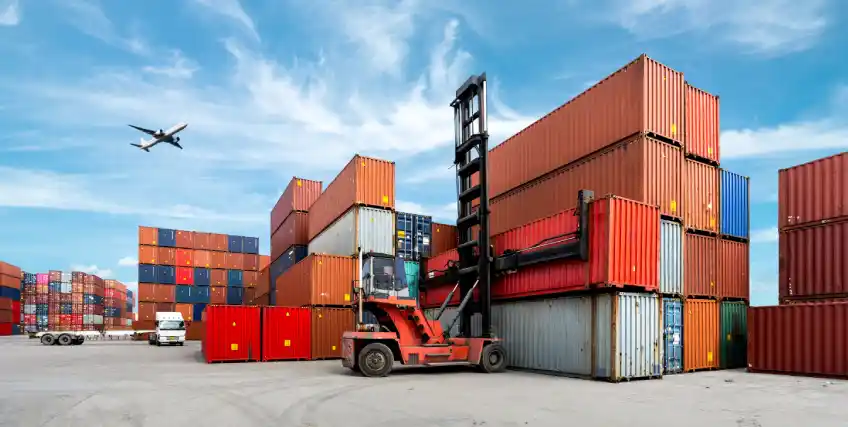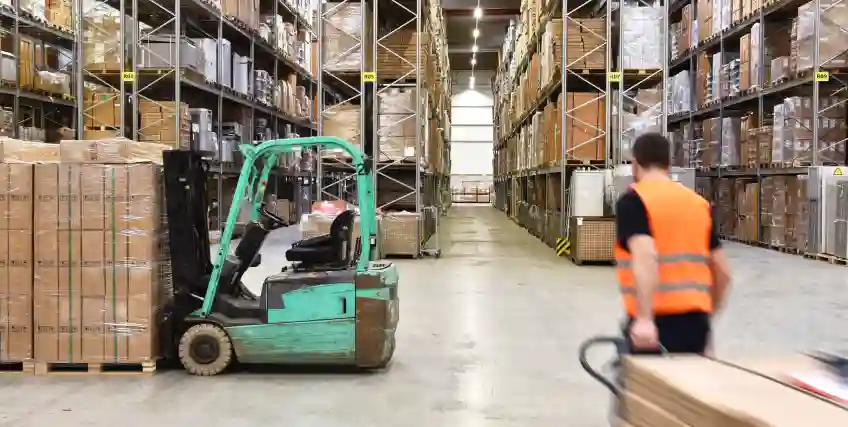Power Your Supply Chain
With Flexible Logistics Loans
Looking for Business Financing?
Apply now for flexible business financing. Biz2Credit offers term loans, revenue-based financing, lines of credit, and commercial real estate loans to qualified businesses.
Set up a Biz2Credit account and apply for business financing
The logistics industry moves nearly everything, be it raw materials or final goods. But staying competitive in this sector isn’t cheap. Fleet upgrades, route tech, fuel costs, and warehousing keep rising. That’s why logistics loans have become a key part of how logistics firms manage their day-to-day and long-term operations.
US-based logistics companies are facing tighter margins, rising interest rates, and labor shortages. When fuel surges or supply chains break, even well-run companies can feel the pinch. These shifts create an urgent demand for accessible business financing. Whether it’s for working capital, seasonal slowdowns, or expanding into new regions, access to fast and reliable capital has become more than a backup—it’s a necessity.
Most logistics loans today are used to purchase new trucks, fund payroll during contract delays, or secure warehousing. But the right financial solutions can also help logistics owners automate systems, streamline routes, or strengthen their business plan to compete with national carriers.
In short, if you're in the transportation industry, you need funding that works at the pace of your business. Flexible loan terms, smooth application processes, and smart repayment structures help these companies stay resilient.
According to the U.S. Department of Transportation, the logistics and freight sector plays a direct role in the country’s $23 trillion economy, with millions of small and mid-size operators supporting the supply chain daily.
Where Logistics Businesses Spend Their Capital
In the logistics world, costs move just as fast as trucks. From equipment to compliance, there is a constant need for capital inflow. This is where logistics loans can really come in handy and keep the business moving. We have listed the top areas where logistics companies generally invest their funds to maintain operations and grow.
1. Fleet Maintenance & Expansion
Fleet costs don’t end with buying the trucks. Maintenance, upgrades, and replacing aging vehicles are major expenses. Whether it’s box trucks, trailers, or long-haul semis, these costs add up fast. Many businesses rely on logistics loans or equipment financing to cover these needs without draining cash reserves. Keeping your fleet road-ready is key to meeting delivery timelines and avoiding delays.
2. Fuel and Route Operations
Fuel remains one of the highest recurring costs for the logistics industry. When prices rise, profit margins tighten quickly. Logistics loans offer a buffer to manage these spikes, keep vehicles running, and support expanded route coverage. With smart use of working capital, businesses can better navigate fluctuating fuel markets and ensure their delivery schedules stay on track.
3. Warehouse and Storage Needs
Whether renting or owning, warehousing comes with costs. Climate control, insurance, utilities, and staff salaries all require steady cash flow. Logistics company loans can help pay for expansions, secure short-term leases, or upgrade storage tech. As supply chains grow more complex, having the right warehouse setup matters more than ever.
4. Tech Investments for Route Optimization
Smart routing, GPS integration, and freight tracking systems reduce errors and fuel use. But these upgrades cost money upfront. Logistics financing options make it easier to adopt tech that lowers costs in the long run. Investing in automation, digital dashboards, and dispatch systems also helps logistics businesses meet client expectations.
5. Insurance and Compliance Costs
From Department of Transportation (DOT) re gulations to driver safety programs, compliance isn’t optional. These costs can’t be deferred and often require lump sum payments. Logistics loans support payment of insurance premiums, DOT audits, and regulatory upgrades, ensuring that companies stay compliant without hurting day-to-day operations.
Smart Ways to Use Logistics Loans
Cash gaps can stall deliveries, delay hires, or cost contracts. That’s why knowing how to make the most of your funding is key. Here are four smart ways logistics loans can meet urgent and strategic needs in the logistics business.
1. Buy or Lease Trucks and Trailers
New vehicles aren’t cheap, and used ones still need upfront capital. Logistics loans help secure trucks, vans, trailers, and flatbeds without tying up working capital. With clear loan terms and fixed repayment, companies can scale their fleet while keeping their cash flow stable. This improves delivery capacity and prepares them for larger contracts.
2. Hire Drivers and Logistics Staff
As demand grows, so does the need for trained drivers and dispatchers. Hiring often requires immediate funds for onboarding, insurance, and payroll. Logistics financing gives companies the ability to cover these costs upfront and repay as revenue flows in. It's a vital option when contracts depend on staff availability.
3. Manage Delayed Client Payments
Waiting 30 to 60 days for invoice payments can squeeze even the busiest logistics companies. With logistics loans, businesses can avoid taking on unnecessary debt through cash advances or business lines of credit that cover receivables. This helps maintain fuel supply, payroll, and warehouse operations.
4. Bridge Seasonal Demand Gaps
Peak shipping seasons can shift overnight, and transportation companies must be ready. Short-term logistics loans help bridge dry spells and prepare for busy months. This ensures continuity and positions the company for stronger contract negotiations with major shippers.
Types of Logistics Financing Options
Not all capital is created equal. For the logistics industry, choosing the right type of financing depends on your business size, cash flow cycle, and specific equipment or service needs. Below are the most commonly used logistics loans and how they work.
1. Term Loans
Term loans are one of the most widely used financing options in the logistics space. They give a lump sum upfront and offer fixed monthly payments over a set period. These loans are ideal for purchasing high-cost equipment, trailers, or expanding your truck fleet. With predictable repayment terms, businesses can plan long-term without straining operations.
2. Equipment Financing
Buying large assets like forklifts, cranes, or conveyor belts can be costly. Equipment financing helps cover these upfront costs while using the asset itself as collateral. This preserves working capital and improves efficiency in storage and handling operations. It’s a common tool used by warehousing firms and fleet-heavy logistics providers.
3. Invoice Factoring to Handle AR Delays
Delayed receivables can choke your cash flow. Invoice factoring lets logistics companies sell their unpaid invoices to a third party and get funds immediately. It’s not a loan, so there's no debt but the tradeoff is a fee. This method helps business owners avoid gaps in payroll, fuel, and overhead expenses.
4. Working Capital Loans for Fuel and Payroll
Working capital loans offer flexible funding to cover daily costs like payroll, fuel, insurance, or short-term repairs. These are helpful when seasonal shifts or contract changes throw off your cash flow. They’re typically faster to obtain than larger business loans and come with fewer restrictions on how the funds can be used.
Common Benefits and Drawbacks of Logistics Loans
Every loan has trade-offs. For logistics companies, the key is weighing those risks and benefits before signing any agreement. Here's a quick look at the real advantages and challenges that come with using logistics loans.
Benefits
1. Fast Access to Funds
Many logistics loans offer fast approvals and quick disbursals, making them a good fit for businesses that need capital urgently to secure contracts or replace vehicles.
2. Flexible Financing Solutions
Depending on your needs, you can opt for term loans, lines of credit, or working capital loans. This flexibility helps address both short-term gaps and long-term growth plans.
3. Supports Business Expansion
Loans can fund more trucks, warehouse space, or staffing, allowing small or mid-sized firms to scale and compete with national transportation companies.
Drawbacks
1. High Interest Rates for Low Credit
Borrowers with a weaker credit score may face steeper interest rates or tighter loan terms, which can raise the overall cost of the loan.
2. Strict Documentation Requirements
Lenders often request detailed financial statements, tax filings, and proof of business needs. The application process can be time-consuming, especially for newer companies.
3. Risk of Overborrowing
Taking on more debt than you can handle may disrupt your cash flow or reduce your eligibility for future loans. It’s important to only borrow what your logistics business can repay.
What Lenders Look for in Logistics Loan Applications
More often than not, applicants get rejected because they are unable to show lenders that they are ready. Lenders look for proof to validate the fact that your business is stable, revenue-positive and capable of managing debt. Here's what they tend to check before approving logistics loans.
To start with, your credit history has a big role to play. If you have a strong credit, it shows you've managed your past obligations responsibly. However, it does not mean that you cannot secure logistics loans with low scores. But your path to financing might become slightly difficult as business loans with low or bad credit scores often come with higher interest rates or stringent terms. Some lenders may also check your personal credit score if your business is new.
Second, your revenue trends and financial statements matter. Lenders want to see stable or growing monthly income, especially if you’re applying for working capital loans or a small business loan. Showing strong accounts receivable and a healthy pipeline of contracts can improve your odds.
Third, the age of your business can influence the type of loan you qualify for. Established logistics firms often have more options than a startup, but newer companies with a solid business plan and clean records can still get approved.
Finally, be ready to explain the loan’s purpose. Whether it’s equipment financing, expanding warehouse space, or handling seasonal cash flow, clear documentation helps lenders assess fit and risk.
How to Prepare Before Applying for Logistics Loans
There are a few steps you need to take before even approaching a lender. A well-prepared application will go a long way to increase your chances of loan approval. Fret not! Here's what your logistics business can do before applying for logistics loans.
1. Gather Key Financial Documents
Lenders will want to see tax returns, bank statements, profit and loss reports, and other financial statements. These give insight into your cash flow, debt levels, and revenue history. Organized paperwork tells lenders that your operation is stable and transparent. It also helps determine the right loan amount for your needs.
2. Check Your Credit Health
Before applying, check both your business and personal credit score. Many lenders rely on this score to decide risk and interest rates. If your score is low, try reducing outstanding debts or disputing errors before applying. A solid credit history can open better loan terms and faster approvals.
3. Define Your Loan Purpose
Be specific about how you’ll use the funds. Whether it’s equipment financing, expanding routes, or managing working capital, lenders want to know your plan. A clear use case shows you’ve thought things through and helps match you to the right type of financing.
Trusted by Thousands of Small Business Owners in America.**
Simply because we get what you go through to build a business you believe in.
**Disclaimer: All stories are real, as told by real business owners. Customers do not receive monetary compensation for telling their stories.
From One Entrepreneur to Another: We Get You
We understand what's behind building a business you believe in.
All stories are real, as told by real business owners. Customers do not receive monetary compensation for telling their stories.



Articles on Loans for Logistics Services
Cash Flow Mistakes Logistics Companies Make When Applying for Loans
Running a logistics company in the U.S. means facing constant expenses. From rising fuel costs to late-paying clients, money flows...
How to Get a Business Loan for Your Logistics Startup
Starting a logistics business requires an adequate amount of working capital along with a good business idea. It also needs wheels...
Popular Financing Options for Small Logistics Companies
To run a logistics company in the U.S., comes with consistent challenges. This includes rising fuel costs, unpredictable delays, and...
Frequently Asked Questions on Logistics Loans
1. What are logistics loans used for?
Logistics loans are used to fund business essentials like fleet purchases, warehouse leases, payroll, fuel, and compliance upgrades. They support both day-to-day costs and growth plans.
2. Can I get logistics financing if I run a startup?
Some lenders offer logistics financing to startups, though terms may be tighter. A strong business plan and updated financials improve your eligibility.
3. Are there loans for logistics services with bad credit?
Some lenders work with lower credit score borrowers. However, rates may be higher and terms shorter. Strong cash flow can help balance risk.
4. Can I use the loan for warehouse expansion?
Many logistics loans are used for real estate needs like leasing new warehouse space or upgrading existing storage facilities to meet demand.
5. Is invoice factoring the same as a logistics loan?
Invoice factoring is not a loan. It’s a form of financing where unpaid invoices are sold for cash. It’s often used to ease cash flow gaps.
Frequent searches leading to this page
Term Loans are made by Itria Ventures LLC or Cross River Bank, Member FDIC. This is not a deposit product. California residents: Itria Ventures LLC is licensed by the Department of Financial Protection and Innovation. Loans are made or arranged pursuant to California Financing Law License # 60DBO-35839



